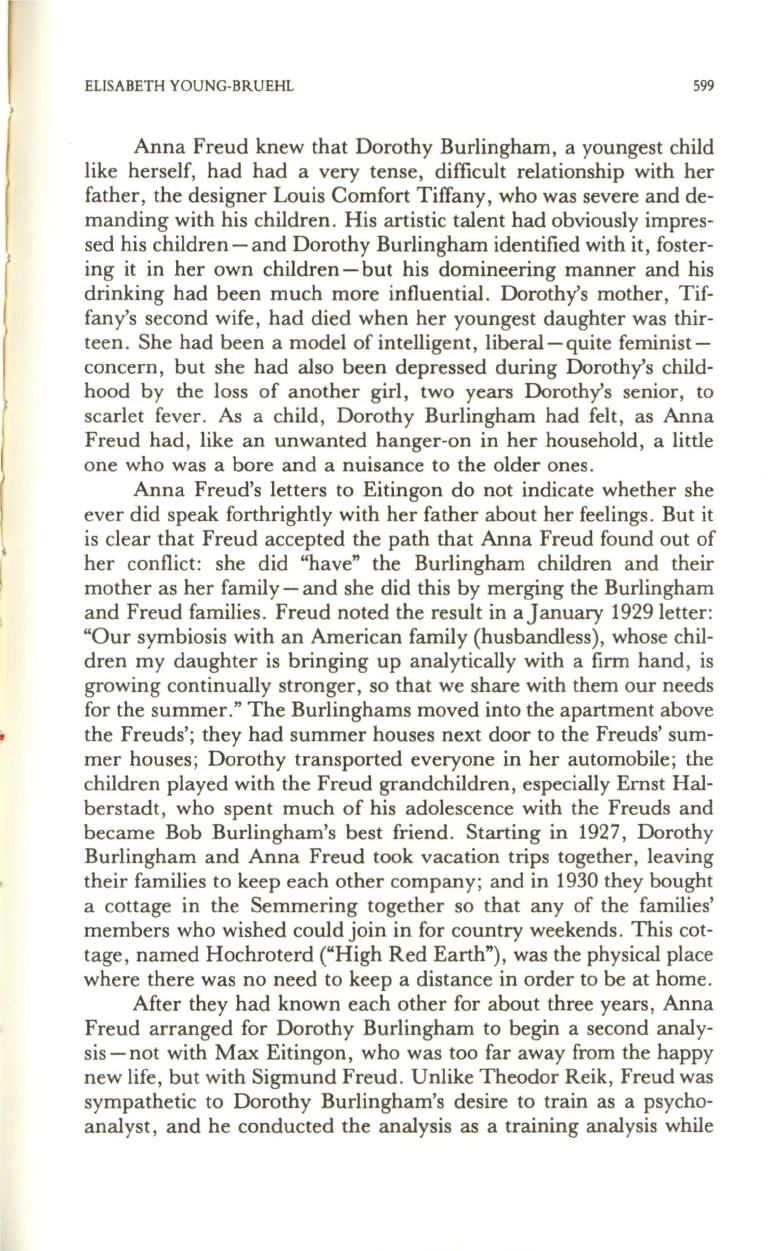
ELISABETH YOUNG-BRUEHL
599
Anna Freud knew that Dorothy Burlingham, a youngest child
like herself, had had a very tense, difficult relationship with her
father, the designer Louis Comfort Tiffany, who was severe and de–
manding with his children. His artistic talent had obviously impres–
sed his children - and Dorothy Burlingham identified with it, foster–
ing it in her own children - but his domineering manner and his
drinking had been much more influential. Dorothy's mother, Tif–
fany's second wife, had died when her youngest daughter was thir–
teen. She had been a model of intelligent, liberal-quite feminist–
concern, but she had also been depressed during Dorothy's child–
hood by the loss of another girl, two years Dorothy's senior, to
scarlet fever. As a child, Dorothy Burlingham had felt, as Anna
Freud had, like an unwanted hanger-on in her household, a little
one who was a bore and a nuisance to the older ones.
Anna Freud's letters to Eitingon do not indicate whether she
ever did speak forthrightly with her father about her feelings. But it
is clear that Freud accepted the path that Anna Freud found out of
her conflict: she did "have" the Burlingham children and their
mother as her family - and she did this by merging the Burlingham
and Freud families. Freud noted the result in aJanuary 1929 letter:
"Our symbiosis with an American family (husbandless), whose chil–
dren my daughter is bringing up analytically with a firm hand, is
growing continually stronger, so that we share with them our needs
for the summer." The Burlinghams moved into the apartment above
the Freuds'; they had summer houses next door to the Freuds' sum–
mer houses; Dorothy transported everyone in her automobile; the
children played with the Freud grandchildren, especially Ernst Hal–
berstadt , who spent much of his adolescence with the Freuds and
became Bob Burlingham's best friend. Starting in 1927, Dorothy
Burlingham and Anna Freud took vacation trips together, leaving
their families to keep each other company; and in 1930 they bought
a cottage in the Semmering together so that any of the families'
members who wished could join in for country weekends . This cot–
tage, named Hochroterd ("High Red Earth"), was the physical place
where there was no need to keep a distance in order to be at home .
After they had known each other for about three years, Anna
Freud arranged for Dorothy Burlingham to begin a second analy–
sis - not with Max Eitingon, who was too far away from the happy
new life, but with Sigmund Freud . Unlike Theodor Reik, Freud was
sympathetic to Dorothy Burlingham's desire to train as a psycho–
analyst, and he conducted the analysis as a training analysis while


